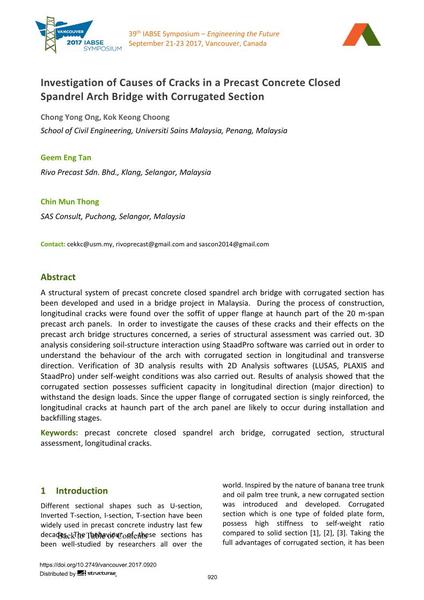Investigation of Causes of Cracks in a Precast Concrete Closed Spandrel Arch Bridge with Corrugated Section

|
|
|||||||||||
Détails bibliographiques
| Auteur(s): |
Chong Yong Ong
(School of Civil Engineering, Universiti Sains Malaysia, Penang, Malaysia)
Kok Keong Choong (School of Civil Engineering, Universiti Sains Malaysia, Penang, Malaysia) Geem Eng Tan (Rivo Precast Sdn. Bhd., Klang, Selangor, Malaysia) Chin Mun Thong (SAS Consult, Puchong, Selangor, Malaysia) |
||||
|---|---|---|---|---|---|
| Médium: | papier de conférence | ||||
| Langue(s): | anglais | ||||
| Conférence: | IABSE Symposium: Engineering the Future, Vancouver, Canada, 21-23 September 2017 | ||||
| Publié dans: | IABSE Symposium Vancouver 2017 | ||||
|
|||||
| Page(s): | 920-927 | ||||
| Nombre total de pages (du PDF): | 8 | ||||
| Année: | 2017 | ||||
| DOI: | 10.2749/vancouver.2017.0920 | ||||
| Abstrait: |
A structural system of precast concrete closed spandrel arch bridge with corrugated section has been developed and used in a bridge project in Malaysia. During the process of construction, longitudinal cracks were found over the soffit of upper flange at haunch part of the 20 m-span precast arch panels. In order to investigate the causes of these cracks and their effects on the precast arch bridge structures concerned, a series of structural assessment was carried out. 3D analysis considering soil-structure interaction using StaadPro software was carried out in order to understand the behaviour of the arch with corrugated section in longitudinal and transverse direction. Verification of 3D analysis results with 2D Analysis softwares (LUSAS, PLAXIS and StaadPro) under self-weight conditions was also carried out. Results of analysis showed that the corrugated section possesses sufficient capacity in longitudinal direction (major direction) to withstand the design loads. Since the upper flange of corrugated section is singly reinforced, the longitudinal cracks at haunch part of the arch panel are likely to occur during installation and backfilling stages. |
||||
